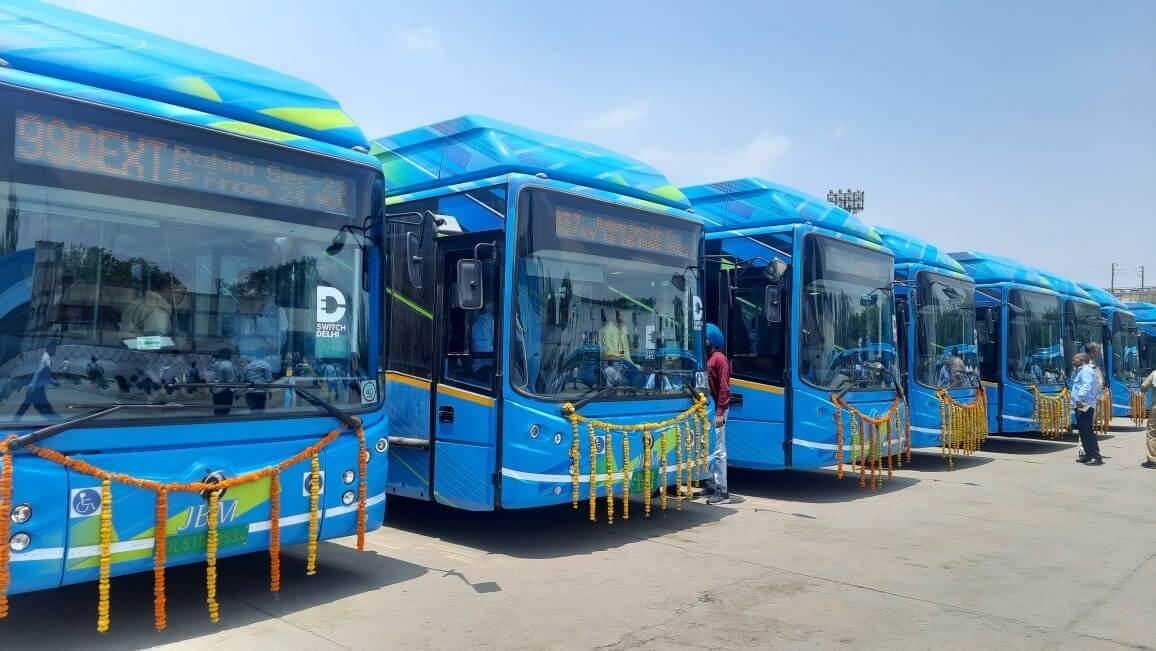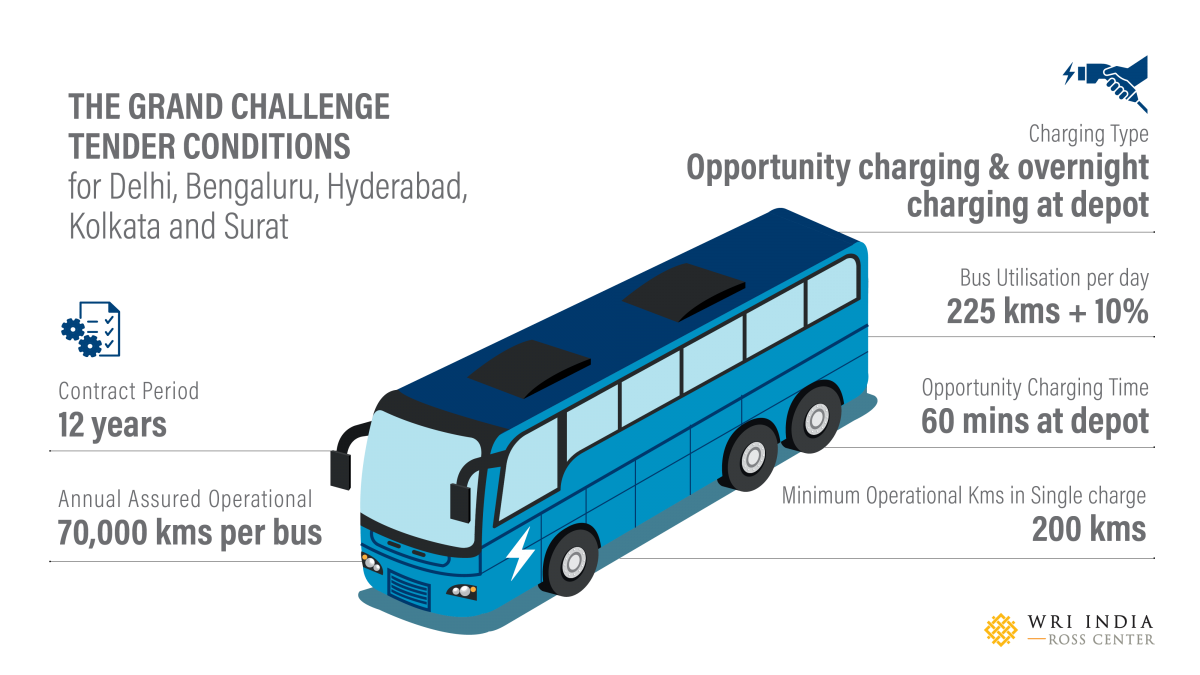Expanding the Footprint of the Grand Challenge Across Tier-II India

This is the second blog in our three-part blog series, that explores key insights and learnings of the Grand Challenge and electric bus procurement in urban India. Read the first blog in the series here.
The Grand Challenge is a giant stride towards the electrification of India’s public transport, paving the way for accessible, affordable, safe, and clean public transport. Under the Grand Challenge, the state-owned Convergence Energy Services Limited (CESL) announced one of the world’s largest electric buse (e-bus) procurement tenders, focusing on the deployment of 5,450 e-buses in India. The Grand Challenge, aimed at benefiting state transport agencies (STUs), aggregates demand for e-buses supported under the government’s FAME-II scheme.
This endeavor managed to achieve harmonization of specifications across five major cities: Delhi, Bengaluru, Hyderabad, Kolkata and Surat.
Some highlights of the tender were:
- Tata Motors was the lowest bidder with a quote of Rs 5,000 crores for 5,000 vehicles.
- The mega size of the tender was instrumental in reducing the overall bid rates. The large lot size of buses per transit agency also helped original equipment manufacturers (OEMs) negotiate with suppliers.
- The tender rate was reduced 39.8% (from Rs. 79 per km to Rs. 47.49 per km) with the increase in bus lot sizes — that increased from 300 e-buses procured by Delhi Transport Corporation (DTC) to 1500 e-buses under the CESL Grand Challenge tender for Delhi.
- The lowest price discovered for 5,450 e-buses without subsidy was 27% cheaper than diesel buses and 23% cheaper than CNG buses in Delhi.
- Surat and Hyderabad also benefitted from lower rates despite procuring only 150 buses, owing to the larger lot size for e-buses.

According to a report released by WRI India, India needs to operationalize at least 5.85 lakh buses by 2031. Around 3.38 lakh of these buses will be offset by the business as usual (BAU) procurement patterns of public and private operators with an additional requirement of 2.46 lakh buses by 2031. To meet this target, India needs to formulate a national-level program to access the aggregated demands of tier-II cities that has the added benefit of boosting localization of electric bus component manufacturers.
What needs to be kept in mind while expanding the framework to tier-II cities?
The government now plans to expand the Grand Challenge to tier-II cities with the aim of reaching 50,000 e-buses by 2030. The travel demand, travel conditions and traffic congestion conditions vary from city to city, and it will affect the average vehicle utilization in terms of operational kilometers travelled by bus. With the reduction in vehicle utilization, cities might not be able to run the assured kilometers that would further result in authorities compensating the operators for remaining kilometers and thereby increasing the actual effective cost per km.
City-specific travel demands need to be analyzed and evaluated thoroughly considering the futuristic scenarios stated above. The following factors also need to be considered:
- The unique demand of each city must be carefully analyzed, and the tender conditions must be tailored accordingly.
- Cities should be evaluated based on parameters such as range requirements, inter and intra-city travel demand patterns and type of buses (standard, midi and minibuses).
- To avoid disputes due to unwarranted interlinkages between supply and service contracts, the tender document should be formulated based on the gross cost contracting and better contract management practice.
- The successful scaling of this program to tier II cities would also require the availability of viable financing options at the national level.
- The quality and standardization of infrastructure should be another focus area for the electrification of public transport in these cities.
How can original equipment manufacturers expand electric buses adoption?
OEMs will be evaluated based on their supply chain readiness for their current production capacity and expansion capability. A healthy competitive environment needs to be built amongst different OEMs to ensure quality services and timely delivery of key components and technology.
With the EV battery being one of the most important components of an electric bus, OEMs should work towards evaluating bus battery health to arrive at assured kilometers requirement for each city. It is recommended that operators and cities opt for operations with higher assured kilometers as this is expected to gradually decrease with time as the battery ages.
Lastly, a comprehensive approach towards tendering must be considered that is a mix of standard basic requirements and city-specific requirements — such as the bus-mix that best meets a city's needs.
It is a challenge to bring different smaller cities, with very specific demand sets, onto common ground. This is exactly what the expanded Grand Challenge hopes to achieve as it sets forth the road map for bus electrification across urban India
View the first blog in our three-part series -
Key Lessons for India’s Bus Electrification Drive
Sanjay Bhatia is a Senior Consultant for the Sustainable Cities & Transport Program at WRI India.
About TUMI
Transformative Urban Mobility Initiative (TUMI) is the leading global implementation initiative on sustainable mobility formed through the union of 11 prestigious partners. TUMI supports transport projects all around the world and enables policymakers to transform urban mobility. TUMI supports innovative pilot projects around the world and shares knowledge with planners about modern mobility concepts. earn more about TUMI at: About | (TUMI) (transformative-mobility.org)
About TUMI E-Bus Mission
The TUMI E-Bus Mission is working with six global partners in 20 deep-dive cities to dramatically advance electric bus adoption across leading cities in the Global South. This mission is part of the Action Towards Climate Friendly Transport (ACT) initiative and TUMI, and is supported by the Federal Ministry for Economic Cooperation and Development (BMZ). Learn more about TUMI e-Bus Mission at: https://bit.ly/3pLcSN4
TUMI E-Bus Mission
